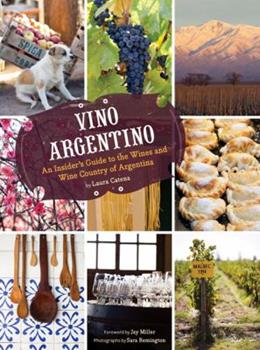Book Review:
Vino Argentino
Written by Laura Catena
Photos by Sara Remington
2010 publication, 240 pages
I was buying wine books on eBay and the vendor had a promotion of 4 books for the price of 2, so I threw this into the basket. I was not expecting much, as my initial expectations were that it seemed like a ghost written vanity coffee table book, but it was much better than I’d hoped, and I actually recommend it, especially in light of how cheap these go for in secondhand stores ($3-4). Given how high energy Dr. Catena is (she’s Harvard undergrad and Stanford med school!) and how authentic it ‘feels’ I do think it’s her work, somehow cobbled together when she’s not working as an ER doctor AND the CEO of the family wine business.

The layout is slightly different from the usual wine tomes but begins with the usual primer on whatever the topic is. In this case it leads off with 20 pages on the history of the region - mostly Mendoza - and a little on their star Malbec along with much depth on the family history. The pictures are excellent, and on nearly every page, although are not captioned. The next 20 pages, which are a separate section are on the traditions and European influence on the nation. The importance of beef and local ways of preparing it are discussed. It seems like a tough place for vegans!
After that, the book begins the conventional regional sections of wine books, with each region spotlighted in a section: Mendoza City, Eastern Mendoza, Maipu/Lujan de Cuyo, Perdriel, Agrelo, Uco Valley, Tunuyan/San Carlos, Patagonia, Salta. The final regular chapter is a set of practical pointers on dealing with Buenos Aires and touring Wine Country. Sadly in that chapter, there is plenty of safety cautions.
The sections are not all laid out in the same formula. One region might have a discussion of various vine training methods that are used in Argentina, and why its different than Europe. Another might have commentary on unique hail problems due to the high altitude of many vineyards. There is acceptance of irrigation, even if dry farming may be a talking point for most fine wine regions, and explanations for local conditions. In one section there is a little bit on the advantages of working with own rooted varietals along with soil issues in the high desert, which is not a topic a coffee table book normally would explore. Interspersed with these detailed viticulture snippets are paragraphs on local attractions like a museum or a local shrine to a gaucho, so the book sort of feels like a mash up of a tourguide along with a wine tome. The producer profiles are all unfailingly complimentary, and Dr Catena does have a bit of a cheerleader style to her writing. This is not a critic discussing a consumer product; this is the work output of an incented player in the game. She also discusses the extensive range of foreign owners and traveling consultants (Paul Hobbs and Michel Rolland among others are profiled with full pages) which is appreciated candor, and validation, for the region. Some sections even have commentary on the architects commissioned for all the new wineries that have been built. (I’ve seen the pictures/site for Monteviejo which seems most impressive)
The final sections are recipes - which actually appear interesting and not filler, a glossary, contacts for named estates/hotels/restaurants, and then a bibliography.
Pictures are charming and appear to be commissioned for the book, paper stock is thick but the maps are vague and only a few are included at the end. Each section really should have had its own map, with prominent areas/estates denoted. The book is medium sized and easy breezy reading, I think it took 2-3 nights to read, maybe an hour each night. (There are lots of pictures)
I know little about the nation and rarely drink their wines, as the only ones that have been memorable over the decades have been a Weinert and a Monteviejo. Both have some Bordelais influence as the book notes, which might explain why I liked them. So for someone at my low level of interest/experience, I found Vino Argentino fun, and for the money, a good value. Overall: although not a pure wine book – as its also a tour guide, a primer, and a history – I enjoyed it and would recommend it for enthusiasts interested in learning more.